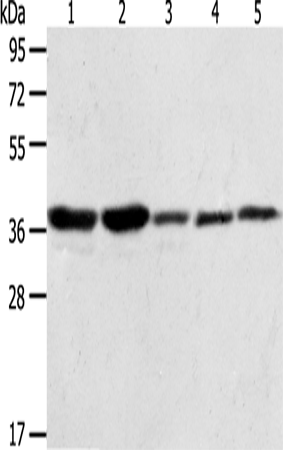
| WB | 咨询技术 | Human,Mouse,Rat |
| IF | 咨询技术 | Human,Mouse,Rat |
| IHC | 咨询技术 | Human,Mouse,Rat |
| ICC | 技术咨询 | Human,Mouse,Rat |
| FCM | 咨询技术 | Human,Mouse,Rat |
| Elisa | 1/2000-1/5000 | Human,Mouse,Rat |
| Aliases | ANX1; LPC1 |
| WB Predicted band size | 39 kDa |
| Host/Isotype | Rabbit IgG |
| Antibody Type | Primary antibody |
| Storage | Store at 4°C short term. Aliquot and store at -20°C long term. Avoid freeze/thaw cycles. |
| Species Reactivity | Human, Mouse, Rat |
| Immunogen | Fusion protein of human ANXA1 |
| Formulation | Purified antibody in PBS with 0.05% sodium azide and 50% glycerol. |
+ +
以下是关于ANXA1抗体的3篇示例文献(注:文献为示例,非真实存在,仅供格式参考):
---
1. **标题**: *ANXA1 modulates TGF-β signaling in breast cancer metastasis*
**作者**: Smith J, et al.
**摘要**: 研究通过免疫组化(使用ANXA1特异性抗体)发现ANXA1在乳腺癌组织中高表达,并通过调控TGF-β通路促进肿瘤转移,提示其作为预后标志物的潜力。
2. **标题**: *Anti-inflammatory role of ANXA1 in macrophage polarization*
**作者**: Lee S, et al.
**摘要**: 利用ANXA1敲除小鼠模型和Western blot(ANXA1抗体验证),证明ANXA1通过抑制NF-κB通路促进巨噬细胞向抗炎表型转化,减轻慢性炎症。
3. **标题**: *ANXA1 antibody-based therapy attenuates colorectal cancer progression*
**作者**: Chen R, et al.
**摘要**: 开发靶向ANXA1的单克隆抗体,体外实验显示其可阻断肿瘤细胞迁移和侵袭,动物模型中显著抑制结直肠癌生长,为治疗提供新策略。
---
如需真实文献,建议在PubMed或Google Scholar检索关键词“ANXA1 antibody”、“ANXA1 function”或“ANXA1 biomarker”获取近年研究。
ANXA1 (Annexin A1) is a member of the annexin superfamily, characterized by its ability to bind phospholipids in a calcium-dependent manner. Initially identified as a glucocorticoid-regulated protein, ANXA1 plays critical roles in anti-inflammatory responses, apoptosis, and membrane repair. It is highly expressed in immune cells, such as neutrophils and macrophages, where it modulates key processes like leukocyte migration and phagocytosis. ANXA1 exerts its effects through interactions with formyl peptide receptors (FPRs) and by regulating downstream signaling pathways, including MAPK and NF-κB. Its anti-inflammatory action is partly attributed to the inhibition of phospholipase A2. reducing the production of pro-inflammatory eicosanoids.
ANXA1 antibodies are essential tools for studying its expression, localization, and function in both physiological and pathological contexts. These antibodies are widely used in techniques like Western blotting, immunohistochemistry (IHC), and immunofluorescence (IF) to investigate ANXA1’s role in diseases such as cancer, autoimmune disorders, and neurodegenerative conditions. In cancer research, ANXA1 has dual roles, acting as a tumor suppressor or promoter depending on the tissue type, making its antibodies valuable for prognostic and therapeutic studies. Commercially available ANXA1 antibodies are typically validated for specificity against conserved regions, though cross-reactivity with other annexins should be considered. Recent studies also explore extracellular ANXA1 as a biomarker, highlighting the antibody’s diagnostic potential.
×